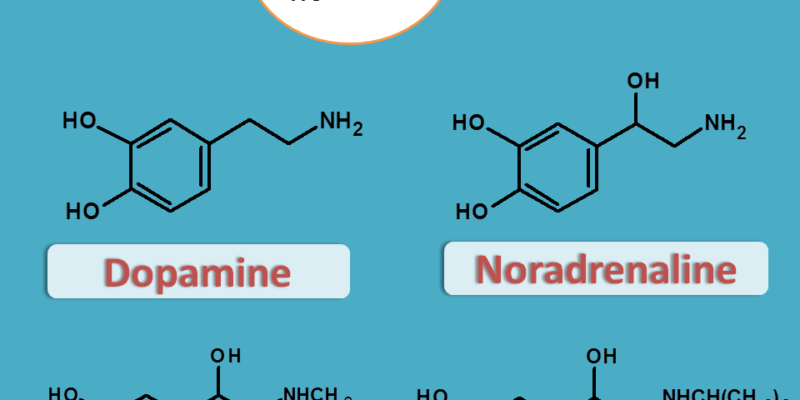
Article Topic: Synthesis of Adrenergic Neurotransmitters
Author: Osama Khaldoun Batiha
Editors: Yazan S. Al-Zamer, Ethar Hazaimeh.
Keywords: Catecholamines, Neurotransmitter, synapse.
Overview
Adrenergic neurotransmitters are catecholamines compounds (They are called catecholamines because of the catechol group in their structures) and it divides into epinephrine (adrenaline), norepinephrine (noradrenaline), and dopamine. Catecholamines act both as neurotransmitters and hormones vital to the maintenance of homeostasis through the autonomic nervous system[1].
These Neurotransmitters are secreted from postganglionic nerve fiber in a junction called a synapse ( the site of transmission of the electrical impulses between two nerve cells (neurons) or between a neuron and a gland or muscle cell (effector)) [2]. The adrenergic receptors are targets of catecholamines, many cells in the body have these receptors and the binding to them will stimulate the sympathetic nervous system (SNS).
Adrenergic neurotransmitter life cycle (pathway) :
Norepinephrine (NE) is the primary neurotransmitter for postganglionic sympathetic adrenergic nerves. It is synthesized inside the nerve axon, stored within vesicles, and then released by the nerve, once the action potential arrives, calcium influx happens and NE is released. Below are the details for the release and synthesis of NE:
The amino acid tyrosine is transported into the sympathetic nerve axon and then Tyrosine (Tyr) is converted to DOPA by tyrosine hydroxylase (rate-limiting step for NE synthesis). DOPA is converted to dopamine in the cytoplasm by dopa-decarboxylase. Now depending on the type of the nerve the dopamine can be converted either to NE or Epi by beta-hydroxylase,
if the neuron is norepinergic, dopamine will be converted to norepinephrine but if the neuron is dopaminergic the dopamine will not be converted and it will stay in the vesicle. An action potential traveling down, the axon depolarizes the membrane and causes calcium to enter the axon, increased intracellular calcium causes the vesicles to migrate to the axonal membrane (The vesicular monoamine transporter (VMAT) is a transport protein and its function in loading the neurotransmitters into transport vesicles) and fuse with the membrane, which permits the NE to diffuse out of the vesicle into the extracellular (junctional) space and then The NE binds to the postjunctional receptor and stimulates the effector organ response[3]. It can also bind to the receptor in the presynaptic neuron (alpha 2 receptor) which is responsible for the negative feedback inhibition of a further release of NE and it can also be engulfed back to the presynaptic neuron by sodium chloride dependent norepinephrine transporter (NET) for future use.
Epinephrine Synthesis and Release:
Epinephrine (Epi) is produced in the adrenal medulla, where the amino acid tyrosine is transformed through a series of reactions to norepinephrine. An enzyme known as phenylethanolamine N-methyltransferase, which is found in the chromaffin cells of the adrenal medulla, catalyzes the methylation of norepinephrine to epinephrine. In addition to the release of epinephrine from the adrenal glands, small amounts of the Epi are also released from the ends of sympathetic nerves[4]. Adrenal medulla secretions are 80% Epi and 20% NE.
Deactivation:
They may diffuse to the liver and get deactivated by MAO (monoamine oxidase) or reuptaken by COMT (catechol methyltransferase) in the postsynaptic membrane and return to packaging in vesicles.
References...



